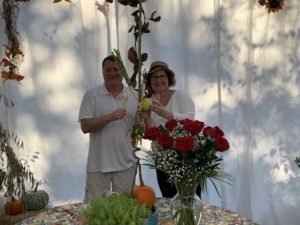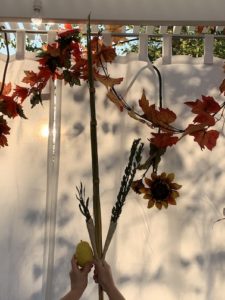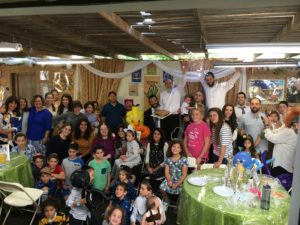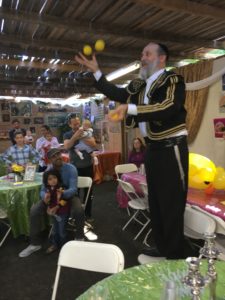Our Anniversary In The Sukkah
Twenty seven years ago, my husband and I stood under the huppa (chuppa) and made our vows to stick together through the best and worst of times and everything in between. We made a commitment to create a life together based on Jewish values under the watchful eye of God, that’s what a huppa is all about.
Today, on the last day of Sukkot, which is also Shabbat, known as Hoshana Rabbah, we are renewing our vows to each other and, by doing certain rituals under the sukkah, we are renewing our vows to God and the the Jewish people.
When I was a bride I clutched a bouquet of ivory roses as I walked down the aisle towards my soon-to-be husband who stood under the huppa waiting for me with a nervous smile on his face. Today, I hold in my hand the sweet smelling fruit called etrog (esrog) with the palm, myrtle and willow branches of the lulav, and wave the Four Species together in all directions in the sukkah. Scott’s still smiling, but this time because I’m shaking my lulav and we’re having strudel for dessert.
Lulav and Etrog Symbolize Unity
I have chosen Sukkot as the theme of this year’s anniversary–why not–considering the actual modern gift associated with the 27th year is “sculptures.” So, here’s my attempt to connect the meaning of the sanctity of marriage to this joyous holiday.
The lulav and etrog can be compared to a married couple, who bring their own unique qualities and strengths to a relationship. A lulav is a slender palm branch that is held together with two willow branches and three willow branches. An etrog, or citron, looks like an enlarged bumpy lemon and a whiff of the subtle scent is heavenly and intoxicating. Together, the branches and fruit have their own beauty and symbolism.
A midrash explains that the Four Species symbolize the importance of unity among different types of Jews. The etrog has both a flavor and a scent, like a Jew who is both learned and observant of the commandments. The lulav is from a date palm, and so it has a taste but no scent. It is likened to a Jew who is learned but does not apply that knowledge in action. A myrtle has a pleasant odor but no taste, and it represents the Jew who has little book learning behind his or her observance. Finally, the willow lacks both fragrance and taste, just like the Jew who neither studies the Torah nor keeps the commandments. These differences among Jews are substantial, yet we can still come together in solidarity, just as the lulav and etrog are bound together to merit a blessing. Same as a married couple. We bring our own unique qualities to the relationship, and we are better, stronger when we are committed as one.
It’s Simchat Torah! Let’s Dance!
Ya know how when you throw an epic party and everyone comes and has a great time, and there’s always one last person to leave? It’s like the ultimate Jewish goodbye. Well that’s my analogy for Simcha Torah, and the guest of honor is God, who wants us to soak in every last bit of happiness and newfound wisdom from the weeklong festival of Sukkot. When we welcome guests into our outdoor huts and we gather together in the beauty of nature and under the stars, we are humble and grateful.  We aren’t focused on material things that separates us, but rather the simple joys that bring us together. My mouth is still watering from dipping soft chewey challah into tahini stuffed eggplant and butternut squash soup, a few of the delicacies that wet our appetites for a feast served inside the sukkah of Rabbi Yosef and Mimi David. Consideirng the meal began after sundown, when the stars appeared, it was a late nite before we said our goodbyes. As we walked down the sidewalk together, we heard the sounds of crickets chirping and the faint singing of neighbors down the street who were still rejoicing after a full day of fun in their annual Yari sukkah party with lots of children, families, balloon making, moon bounce, a juggling rabbi, and a dairy meal of pasta, quiche, and sweets that kept on coming. This feeling of joy is what we strive for when Sukkot is finally over and we move back into our homes and return to our everyday lives. We try to maintain the closeness to each other, to God, and to nature.
The Torah, Like a Matzah Ball, is a Never-Ending Cycle
In the Hebrew month, Tishrei, the season of renewal is not complete without Simchat Torah, which means “Rejoicing the Torah.†This celebration marks the completion of the annual cycle of weekly Torah portions, which is actually five books in one. The Five Books of Moses—Genesis, Exodus, Leviticus, Numbers, Deuteronomy—teach us how Moses received the Torah on Mount Sinai.
On Simchat Torah, we read the last Torah portion in Deuteronomy, then roll back to the Creation Story in Genesis, which reminds us that the Torah is a circle and never ends. Continue reading





